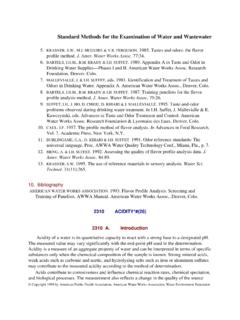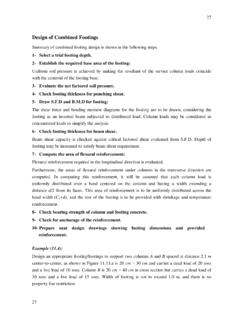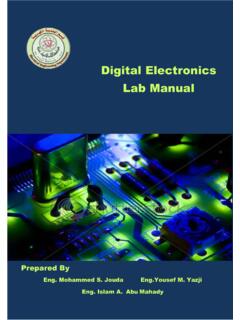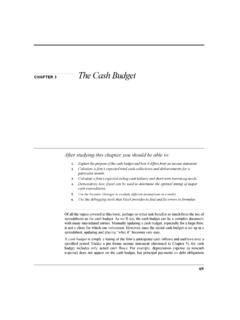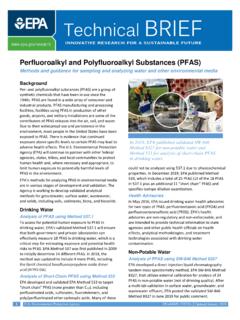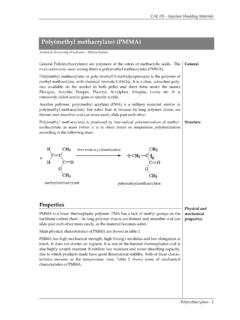Transcription of Lecture 5: Coagulation and Flocculation
1 Lecture 5: Coagulation and FlocculationPrepared byHusam Al-NajarThe Islamic University of Gaza-Environmental Engineering DepartmentWater treatment (EENV-4331)Colour in wateris a water treatment process that causes very small Coagulationsuspended particles to attract to one another and form larger particles. consist of adding a floc-forming chemical reagent to a water to enmesh (catch) or combine with non-settleablecolloidal solids and slow-settling suspended solids to produce a rapid-settling floc. is a water treatment process following Coagulation , Flocculationwhich uses gentle stirring to bring the suspended particles together so they will form larger more settleableclumps called floc.
2 DefinitionsMany of the contaminants in water contain matter in the colloidal form. These colloids result in a stable suspension . In general the suspension is stable enough so that gravity forces will not cause precipitation of these colloidal particles. So they need special treatment to remove them from the aqueous phase. This destabilization of colloids is called Coagulation . Settling times over 30 cmType of particlesDiameter (m) time of particles with a density of 2,650 kg/m3 PrinciplesIn surface water particles difference in sizes are present. A common classification is: Molecules sizes smaller than 1 nm Colloids generally with dimensions between 1 nm and 1 m Suspended matter having sizes larger than 1 m.
3 Colloids:commonly present in surface water are humic acids, proteins, colloidal clay, silica and matter:Bacteria, algae, silt, sand and organic matter -when it is larger than 5-10 m can be removed quite easily by filtration or sedimentation and filtration. The removal of colloids is possible by slow filtration in cases the water is not strongly polluted. of potential determining ions. This involves preferential adsorption of a specific type of ion on the surface of the colloid. Adsorption is usually van derWaals or hydrogen bonding. For example, a surfactant on clay surface, humic acid on silica, OH-on many minerals.
4 The charge that results is a function of concentration and type of ion in solution, pH, etc.)There are several possible origins of primary surface imperfections or isomorphic is very common in clay minerals. For example, the isomorphic replacement of Al3+ for Si4+as shown Ionogenicgroups at surface. (ionizablesurface groups such as carboxyl, amino, hydroxyl, sulfonic, etc.) The charge here is usually dependent on Double Layer (EDL):If we put a charged particle in a suspension with ions, then the primary charge will attract counter ions (opposite charged ions) by electrostatic attraction.
5 The primary charge cannot attract an equal amount of counter charge because a gradient of counterions is established that drives the counterions away from the formation of the electrical double layer (EDL) then occurs via attraction of oppositely charged counterionsby the primary surface charge and then a diffusion of the counterions away from the surface. The counterions are mobile, the primary charge is EDL development is schematically shown here:When colloids are subjected to an electrical field they will migrate generally toward the positive electrode of the field . They move because the inner part of the colloid (with higher charge density than the overall colloid) will respond to the field and leave the outer diffuse layer behind.
6 The EDL actually shears at a planeand the potential (voltage) of the EDL at this shear plane is called the Zeta Potential, zeta potential represents the net charge between the primary charge and the counter charge in the EDL located between the surface and the shear plane. It s with this charge that the colloid interacts with other colloids. As a result of this EDL there is a net electrostatic repulsion/attraction developed between colloids. The net resultant force is a result of:1. attractive potential energy (mostly van der Waals forces), Va. These forces are very strong at short separation distances2.
7 Repulsion potential energy (electrostatic forces), VR. (by Coulomb s law).a61Vr R21Vr The magnitude of these forces is measured by the zeta potential, which is:where: Z is the zeta potential, q is the charge per unit area, d is the thickness of the effective charge layer, and D is the dielectric constant of the Potential ModelThe greater the zeta potential, the greater are the repulsion forces between the colloids and, therefore, the more stable is the colloidal interactions are:The reduction of the zeta potential to a degree where the attractive van der Waals forces and the agitation provided cause the particles to combine.
8 The aggregation of particles by interparticulate bridging between reactive groups on the colloids; The enmeshment of particles in the precipitate floc that is reduce colloidal surface charge and form precipitates that enhance the clustering process and will not settle or filter until they agglomerate to a larger : There are two major forces acting on colloids:1) electrostatic repulsion(simply, negative colloids repel other negatively charged colloids)2)intermolecular, or van der Waals, can be used to reduce the electrostatic repulsive forcesThe electrostatic repulsion reduced by the addition of countercharged ions [Al3+]Chemical Coagulation .
9 The process in which chemicals like Al or Fe salts added to the water to transform the impurities after reaction with the hydrolyzing salts into large flocs, which can be removed easily by sedimentation and of the charge responsible -if high enough -for the net repulsive force will lead to a situation where collisions can occur resulting in is defined -in a stricter sense -as the destabilization of waters with higher ionic strengths the colloids are already present in a destabilized form. Destabilization here has been caused by the mono-and divalent ions present in the water (electrostatic Coagulation ).
10 Coagulants are added here to improve the Flocculation kinetics. After Coagulation the destabilized particles can collide, aggregate so flocs can be formed. This step is called Flocculation . Flocculation : The process of agglomeration of the destabilized particles to such a size that separation by sedimentation and filtration is Flocculation one can make a distinction between perikineticand orthokineticflocculation. Brownian motion is the driving force in the agglomeration of destabilized particles up to m-level perikinetic Flocculation ). Above ~ 1 m the influence of Brownian motion on the collision rate of the particles can be neglected, then artificial mixing is necessary to get an efficient Flocculation .

